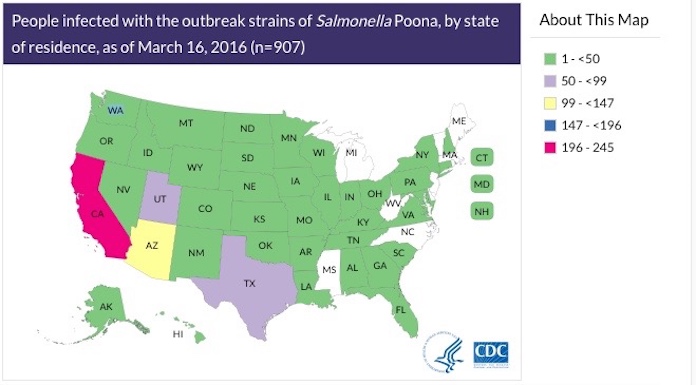The largest multistate food poisoning outbreak in 2016 ended in 2016, but it started in 2015. At least 907 people were sickened with Salmonella Poona infections that were linked to imported cucumbers. Six people died, and 204 people were hospitalized in this massive outbreak.

The strange thing about this outbreak is that even though the cucumbers that were identified as the source of this outbreak, infections were still being reported to officials two months after the recall was issued. Cucumbers do not have a long shelf life.
The cucumbers in question were traced to Rancho Don Juanito de R.L. de C.V. in Baja, Mexico. Two import alerts were issued by the FDA, banning those products from coming into the United States.
Three outbreak strains of Salmonella Poona were identified in this outbreak. These strains were found in cucumbers that were collected from retail locations and in samples taken from the facility that distributed them. Andrew & Williamson Fresh Produce in California imported the cucumbers and sold them to distributors. Investigators isolated the outbreak strains of Salmonella Poona from the Andrew & Williamson Fresh Produce facility.
In a report about this outbreak, the FDA wrote, “The results indicated a high level of contamination in these cucumbers, which could increase the likelihood of cross-contamination of shipping containers or other food contact surfaces.”
The peak of the outbreak was in August and September 2015. The cucumbers were recalled in September 2015. The states with the highest number of cases were Arizona, with 140, California, with 245, Minnesota, with 46, Wisconsin with 46, Utah with 62, and Texas, with 51.
Illnesses started on dates ranging from July 3, 2015 to February 29, 2016. Ill persons ranged in age from less than 1 year to 99. Six deaths were reported from Arizona (1), California (3), Oklahoma (1), and Texas (1). But Salmonella infection was not considered a contributing factor in two of the three deaths in California. Illnesses started on dates ranging from July 3, 2015 to February 29, 2016. Whole genome sequencing showed that isolates from ill persons were closely related genetically.
Illness clusters were an important clue in this investigation. When several unrelated people ate or shop at a same location and get sick within a few days of each other, the contaminated food item was probably served there. There were eleven illness clusters in seven states identified in this outbreak.
Two recalls of garden variety cucumbers were announced. On September 4, 2015, Andrew & Williams recalled all cucumbers sold under the Limited Edition brand label from August 1, 2015 through September 3, 2015. And on September 11, 2015, Custom Produce Sales recalled all cucumbers sold under the Fat Boy brand label.
After the outbreak peak, illnesses did not return to the baseline number for several months for this DNA fingerprint. One hundred twenty seven illnesses started after September 24, 2015, when the cucumbers were no longer available.
Whole genome sequencing showed that the illnesses that occurred after late September 2015 were related to the illnesses that occurred before. Investigators were not able to discover if the illnesses could be explained by cross-contamination within the distribution chain, such as shipping containers.




